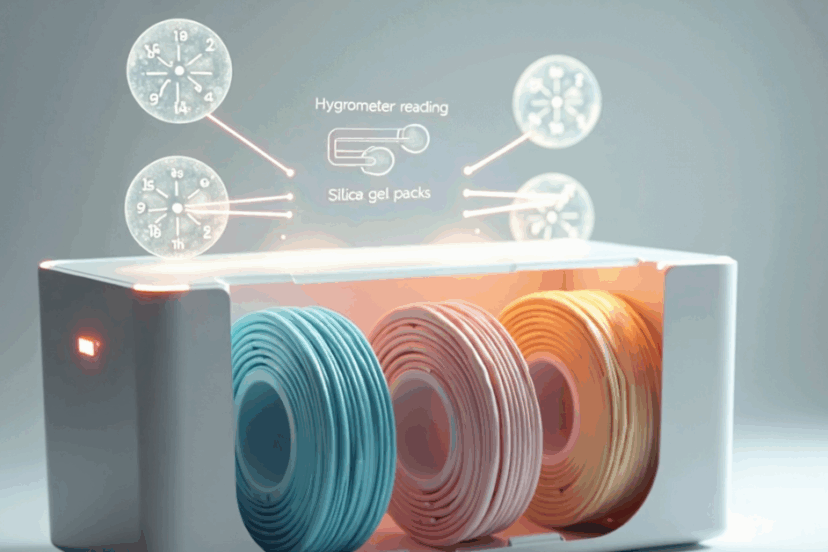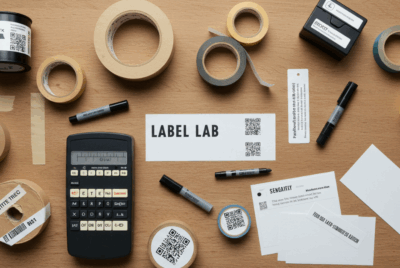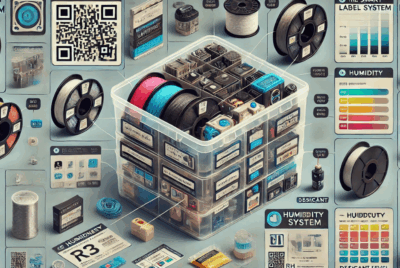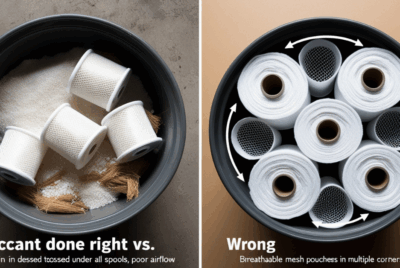Can You Store Multiple Filament Types in the Same Container?
1. One Box to Store Them All?
You’ve got spools of PLA, ABS, TPU, PETG… and only one storage bin.
Can you store them together safely?
Short answer: Sometimes yes—but it depends.
Let’s explore when it’s smart, when it’s risky, and how to do it the right way.
2. Why This Question Matters More Than You Think
Different filament types have different:
- Moisture absorption rates
- Tolerances to heat, light, and humidity
- Storage lifespans
Storing them together might sound efficient—but it could end in ruined prints, brittle filament, or worse: you wasting time and money.
3. The Case For Shared Storage
Storing multiple filaments together can work when:
- All spools are dry and sealed
- You use desiccants or a dehumidifier
- The container is airtight and climate-controlled
- You use a labeling system to keep things organized
This is especially useful for casual users with limited space.
4. The Case Against It
Problems arise when:
- One spool is already moisture-contaminated
- Some spools need lower humidity than others (e.g., Nylon vs PLA)
- You’re using non-airtight bins
- There’s no labeling or separation—spools tangle or contaminate each other
In short, bad storage for one = bad storage for all.
5. Which Filaments Can Be Stored Together Safely?
These filament types have similar moisture sensitivity and storage needs:
| Group | Compatible Filaments |
|---|---|
| Group 1 | PLA, ABS, PETG |
| Group 2 | TPU, TPE, Soft PLA |
| Group 3 | Nylon, PVA, Polycarbonate (needs extra care) |
If you’re storing within the same group—and everything’s dry—it’s generally okay.
6. Which Ones Should Never Mix?
Avoid storing high-moisture filaments with low-sensitivity ones in the same space, such as:
- Nylon or PVA with PLA or ABS
- PVA with any other filament (it absorbs moisture super fast)
Any damp spool with a dry one (moisture can migrate in enclosed bins)
7. Moisture Absorption Rates by Filament Type
| Filament | Hygroscopic Level | Drying Temp (°C) |
|---|---|---|
| PLA | Moderate | 40–45 |
| ABS | Moderate | 60 |
| PETG | High | 65 |
| Nylon | Very High | 70 |
| TPU | High | 55 |
| PVA | Extremely High | 45–50 |
If you group spools together, align them by hygroscopic level to avoid cross-contamination.
8. Storage Conditions: What Matters Most
For successful multi-type storage, focus on:
- Humidity control (aim for <40% RH)
- Airtight containers
- Desiccants or electric dehumidifiers
- Temperature stability (avoid attic or garage temps)
9. Using Compartments or Dividers in One Bin
You can store different filaments in the same container IF you add:
- Individual bags for each spool
- Vacuum sealing where possible
- Labeled zip-top pouches with color-changing desiccant
Keep them together—but individually protected.
10. Can Mixing Filaments Contaminate Spools?
Not chemically. But physically?
- Loose particles or filament dust can transfer
- If spools touch, they can tangle or rub and create static buildup
- If one spool is damp, it can raise the ambient RH in the bin
Best practice: Keep spools wrapped or bagged separately.
11. Will One Type Affect Another Chemically?
Nope. You don’t have to worry about chemical reactions between filament types in storage.
The bigger issue is shared moisture or inconsistent conditions degrading some filaments faster than others.
12. Best Practices for Multi-Filament Storage
- ✅ Use vacuum-sealed bags for each spool
- ✅ Add silica gel packets inside the container
- ✅ Include a hygrometer to monitor humidity
- ✅ Store in a cool, dark space
- ✅ Label spools by type, color, and opened date
13. Ideal Storage Containers for Mixing Types
| Container | Best For | Notes |
|---|---|---|
| Weathertight bins | General multi-type storage | Add hygrometer + desiccant |
| Vacuum boxes | Short-term dry storage | Compact, low RH |
| Storage drawers + bags | Frequent access | Label clearly and rotate spools |
| Dry boxes | Active users | Use multiple compartments or internal bags |
14. How to Label and Track Different Spools
Use simple sticky labels or QR code apps to track:
- Filament type
- Brand and color
- Opened date
- Drying date
- Last-used printer settings
Organization is key when storing multiple filaments together.
15. Final Thoughts: Together, But Not Touching
Yes, you can store different filament types together—if you’re smart about it.
Keep each spool dry, sealed, and labeled. Don’t let your PLA cozy up to some humid Nylon, and never toss an opened spool in without checking its moisture status.
Just like roommates: sharing space is fine—as long as everyone respects the rules.
❓FAQs
- Can I store opened and unopened filament together?
Yes, but make sure opened spools are dried and sealed to prevent contaminating the new ones. - Should I put desiccants inside each individual bag?
Absolutely. More moisture protection = better results. - Is it safe to store TPU and PLA together?
Yes, as long as both are dry and sealed. They have similar sensitivity. - Can I use one dry box for all my filament types?
You can—but monitor humidity closely and avoid mixing overly sensitive filaments like Nylon or PVA with basic ones. - Will mixing brands of filament cause issues?
Not in storage. Print settings might vary, but storage-wise, brand doesn’t matter—dryness does.




